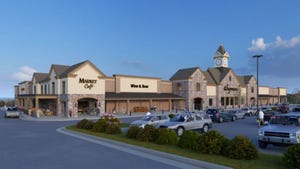Grocery Outlet Sees Opportunity for 4,800 StoresGrocery Outlet Sees Opportunity for 4,800 Stores
Ambitious IPO filing details plans for growth. With discounting a "new normal," the extreme value retailer eyes 10% annual store growth in ambitious IPO filing.

Grocery Outlet hopes to lure investors with a compelling story of reliable growth and profitability—and a very big opportunity for future expansion.
In a stock registration statement filed with the U.S. Securities and Exchange Commission this week in advance of a planned initial public offering, the Emeryville, Calif.-based extreme discounter said it sees the potential to more than double its current 316-store base in states in which it currently operates, and could quadruple its store base to 1,600 locations by expanding to surrounding states.
“Our goal is to expand our store base by approximately 10% annually by penetrating existing and contiguous regions,” the prospectus read. “Over the long term, we believe the market potential exists to establish 4,800 locations nationally.”
That figure—though decades away given current growth rates—would make Grocery Outlet the nation’s largest discount grocer in terms of number of locations: Aldi is currently approaching 2,000 U.S. stores and Save-A-Lot has about 1,230 stores. Grocery Outlet operates stores in California, Nevada, Oregon, Washington, Idaho and Pennsylvania.
Grocery Outlet’s ambitions are rooted in the belief that discount is a long-term trend that will continue to win share from traditional supermarkets—and has been supported by strong financial growth at Grocery Outlet, including 15 consecutive years of comparable-store sales improvements and sales that have more than tripled since 2006. Profit margins have varied between 30.1% and 30.8% over the past decade, the company added.
The company’s sales in the fiscal year ending Dec. 29, 2018, totaled nearly $2.3 billion, up by 10.7%, while comps improved by 3.9% and gross margin as a percent of sales totaled 30.4%. Net income of $15.9 million was down by 23% from 2017. The company carries $875 million in debt.

Art courtesy of Grocery Outlet stock prospectus
“We believe that consumers’ search for value is the new normal in retail,” the filing said. “The success of off-price retailers represents a secular consumer shift toward value as a leading factor in purchasing decisions. Moreover, as millennials mature and baby boomers age, they are increasingly focused on value, driving shopper traffic toward the deep discount channel.”
The prospectus highlighted what Grocery Outlet described as differentiated model for buying and selling resulting in a “Wow” shopping experience. The company sources name-brand consumables and fresh products opportunistically through a centralized purchasing team that leverages long-standing relationships to acquire merchandise at significant discounts including closeouts and overruns. The company sources about 85,000 SKUs overall, but its stores operate with a frequently changing selection of about 5,000 items, “creating a ‘buy now’ sense of urgency that promotes return visits and fosters customer loyalty.”
Grocery Outlet’s stores are independently operated by entrepreneurial small business owners who are responsible for store operations, including ordering, merchandising and managing inventory; marketing locally; and directly hiring, training and employing their store workers. They share in the profits from items sold at their stores.
“This combination of local decision-making supported by our purchasing scale and corporate resources results in a ‘small business at scale’ model that we believe is difficult for competitors to replicate,” the company said.
Although a share price and number of shares to be offered were not included in the S-1, the filing indicates that Grocery Outlet’s current majority owner, the private equity investor Hellman & Friedman, would retain a controlling interest of the company. Erik Ragatz, a partner of Hillman & Friedman, is Grocery Outlet’s chairman.
Hellman & Friedman acquired the company in 2014 from Berkshire Partners. The company, founded in 1946 by Jim Read, is still run by Read’s descendants. CEO Eric Lindberg and Vice Chairman MacGregor Read are cousins and third-generation descendants of Read.
Under Hellman, Grocery Outlet has made numerous infrastructure improvements enabling growth, including a new warehouse management system that has increased distribution labor productivity and improved store ordering capabilities to help reduce shrink, the filing said.
Productivity enhancements are one of three growth strategies identified by the company in the prospectus. Additional unit growth—with 32 new stores expected to open this year—and comp-store growth are the other two strategies.
Grocery Outlet intends to grow comps through deeper relationships with suppliers providing more deals for its retailers. The company cited expansion of its NOSH category (natural, organic, specialty, healthy) and recent additions of grass-fed beef and seafood.
The company said comps would also benefit from an effort to provide independent operators with more data and insights intended to reduce shrink and out-of-stocks, as well as through consumer outreach built around brand awareness and encouraging visits from bargain-minded shoppers through digital and other forms of advertising around its new “Bargain Bliss” campaign.
About the Author
You May Also Like






